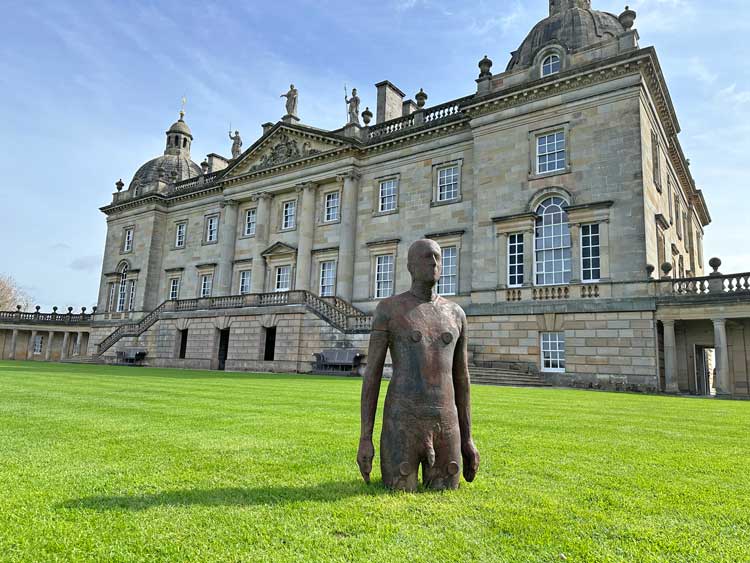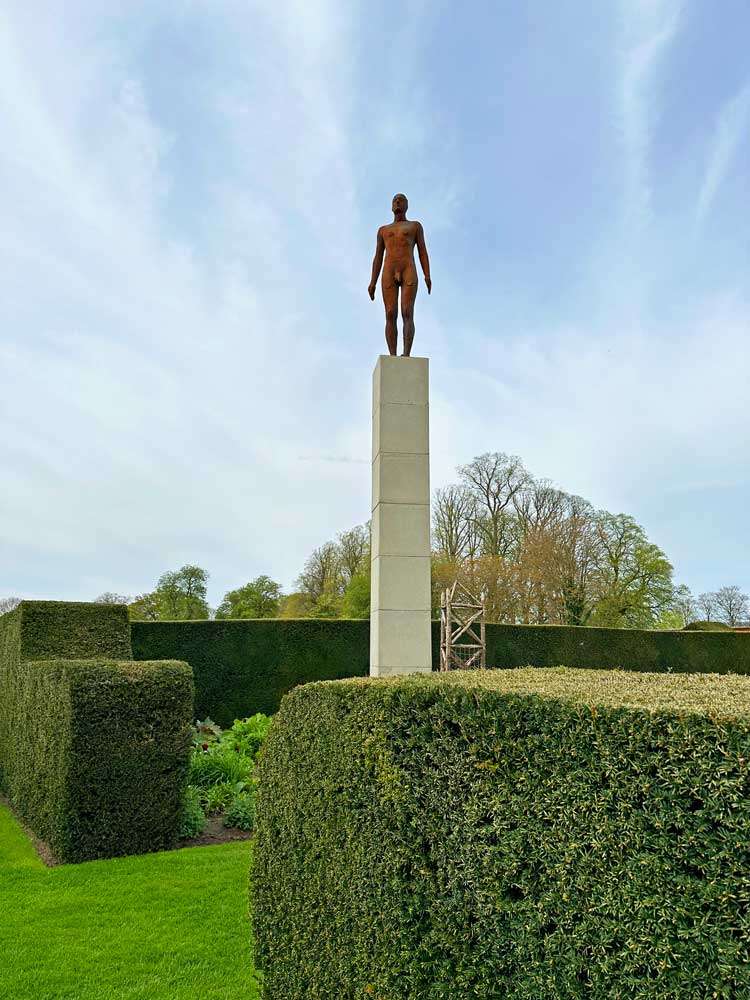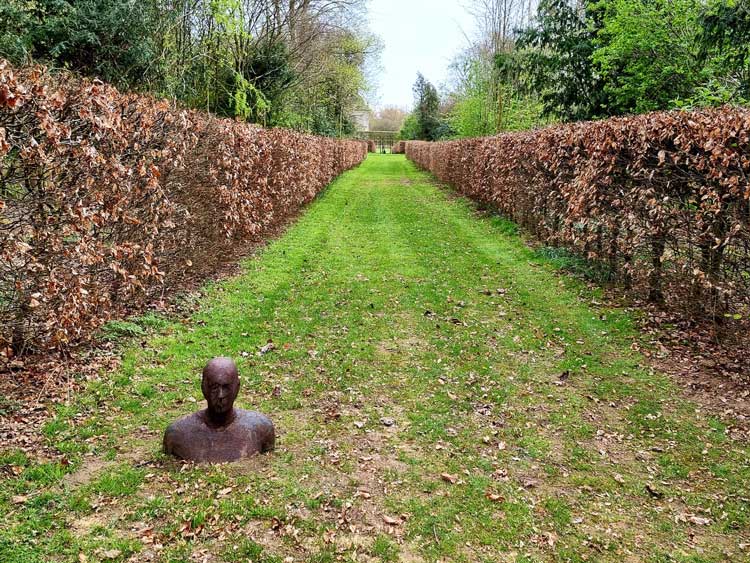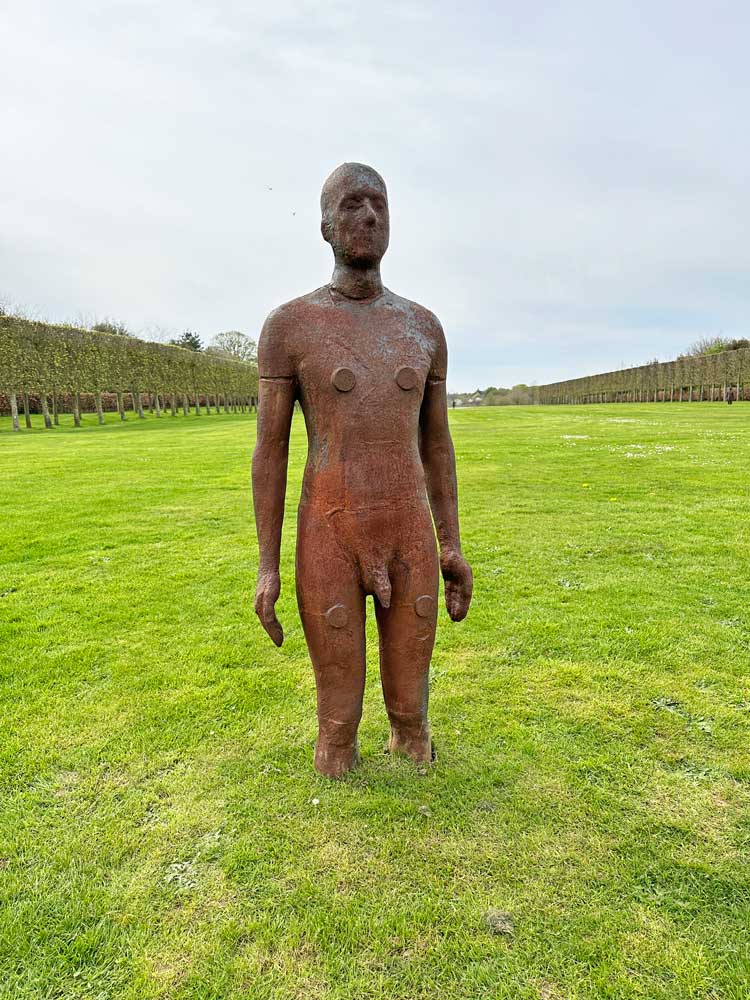Gormley became a household name after creating his towering Angel of the North (Gateshead, 1994-98), but his work more often involves placing multiple smaller human figures in pre-existing environments, challenging viewers to think about our place in the world. He has populated spaces urban and more natural, from Crosby Beach near Liverpool (Another Place, 2005) and London’s South Bank (Event Horizon, 2007) to Western Australia (Inside Australia, 2003) and the Greek island of Delos (Sight, 2019) – and now Houghton.

Antony Gormley: Time Horizon, Houghton Hall, Norfolk, 21 April – 31 October 2024. Photo: Martin Kennedy.
Born into a well-off family in north London in 1950, Gormley was brought up the youngest of seven in a strictly Catholic household (“with the carrot of heaven … and the stick of hell”). His father took him on Sunday outings to museums and art galleries, but was a domineering presence. Gormley has described going to Ampleforth College, a boys’ Catholic boarding school in Yorkshire, as a liberation – and he made the most of its always-open art room.
After studying archaeology, anthropology and history of art at Cambridge (from where he now also has an honorary doctorate), Gormley proceeded to three different art schools, Central Saint Martins, Goldsmiths and the Slade, leaving in 1979.
His first solo show was at London’s Whitechapel Gallery in 1981 – the first of many not only across the UK but around the world in places as disparate as Singapore and Switzerland, Paris and St Petersburg. He won the Turner Prize in 1994, and was awarded an OBE in 1997. Election as a Royal Academician came in 2003 and a knighthood in 2014.

Antony Gormley: Time Horizon, Houghton Hall, Norfolk, 21 April – 31 October 2024. Photo: Martin Kennedy.
Now, at the historic Houghton Hall, built in the 1720s for Britain’s first prime minister, Sir Robert Walpole, and landscaped by William Kent (1685-1748), Gormley has installed 100 life-size naked versions of himself. The cast iron figures – weighing 620kg (97.5 st) each, and very similar but not quite identical – stand at the same datum level, so if they were on flat ground they would all stand at the same height. Since the landscape is not flat, they range from buried up to the neck to raised on high pedestals. In a few cases, it is hard to believe the levels are the same, but that is perhaps part of the thought-provoking point.

This figure, installed in the stone floor of the hallway, is used as the datum level for all 100 sculptures. Antony Gormley: Time Horizon, Houghton Hall, Norfolk, 21 April – 31 October 2024. Photo: Martin Kennedy.
There is one figure inside, its top half sticking out of the stone tiles of the main hallway of this Palladian mansion. Doors are open either side of it creating a visual and actual connection between the gardens on one side of the house and the parkland on the other, as well as the figures spread across both. The statue in the hallway is also the reference point for the datum level governing the vertical placement of all the other statues.

Antony Gormley: Time Horizon, Houghton Hall, Norfolk, 21 April – 31 October 2024. Photo: Juliet Rix.
Time Horizon was first installed in Italy, in a desiccated landscape amid Roman ruins in Catanzaro in 2006. It looks very different in the verdant grounds of Houghton Hall. Gormley says he wants viewers to roam, coming upon the statues and engaging with them and reflecting as they choose.
Studio International followed his instructions, before catching up with the man himself ahead of the exhibition opening.
Antony Gormley: Time Horizon
Houghton Hall, Norfolk
21 April – 31 October 2024
Interview by JULIET RIX
Filmed by MARTIN KENNEDY

Antony Gormley: Time Horizon, Houghton Hall, Norfolk, 21 April – 31 October 2024. Photo: Martin Kennedy.